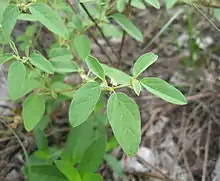| Croton monanthogynus | |
|---|---|
 | |
| Scientific classification | |
| Kingdom: | Plantae |
| Clade: | Tracheophytes |
| Clade: | Angiosperms |
| Clade: | Eudicots |
| Clade: | Rosids |
| Order: | Malpighiales |
| Family: | Euphorbiaceae |
| Genus: | Croton |
| Species: | C. monanthogynus |
| Binomial name | |
| Croton monanthogynus | |
Croton monanthogynus is a species of flowering plant in the spurge family. The undersides are gray. It is a summer annual[1] that produces small, inconspicuous flowers. The plant is monoecious and has both male and female reproductive organs in separate clusters on the same plant. Its leaves are alternate.[2][3] It is native to the southeastern United States and the southern Great Plains. It is considered adventive in more northern states.[4] AL, AR, AZ, GA, IA, IL, IN, KS, KY, LA, MD, MI, MO, MS, NC, NE, OH, OK, PA, SC, TN, TX, VA, WI, WV.[5][6]
The plant in is found in sunny, dry habitats, of both disturbed and high-quality areas.[7] Its common names include prairie tea, one-seed croton, dove weed, and prairie goatweed.[5] Other plant characteristics include alternate leaf arrangement, (or phyllotaxis) and a tap root. It is an annual and it has entire leaf margins, The type of fruit is a capsule, sepals exist on the flowers. The flowers are small and white. It possess glands that emit an unpleasant odor.[8] The plant may grow 6 inches to 3 feet and blooms April through September.[5] The seeds are black.[9]
The plant prefers full sun, dry conditions, and poor soil.[8]
The plant can have a bushy appearance with a flattened top. Dwarf plants may instead, grow to than 6" tall. Croton monanthogynus provides food for wildlife. These species will feed on seeds: sparrows, mourning dove , wild turkey, prairie chicken, bobwhite, and cowbird.[8]
References
- ↑ "Croton monanthogynus". www.sbs.utexas.edu. Retrieved 2019-12-09.
- ↑ "Monecious". Retrieved 2019-12-09.
- ↑ "Lady Bird Johnson Wildflower Center - The University of Texas at Austin". www.wildflower.org. Retrieved 2019-12-09.
- ↑ Flora of North America Croton monanthogynus
- 1 2 3 "Lady Bird Johnson Wildflower Center - The University of Texas at Austin". www.wildflower.org. Retrieved 2019-08-15.
- ↑ "Plants Profile for Croton monanthogynus (prairie tea)". plants.usda.gov. Retrieved 2019-10-08.
- ↑ Croton monanthogynus at Illinois Wildflowers
- 1 2 3 "Prairie Tea (Croton monanthogynus)". www.illinoiswildflowers.info. Retrieved 2019-10-08.
- ↑ "Croton monanthogynus page". www.missouriplants.com. Archived from the original on 2019-10-23. Retrieved 2019-10-15.